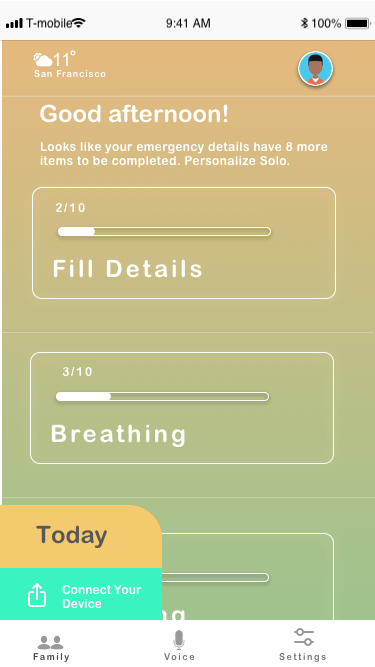Solo
Empathy for Impact +
Designing for human augmentation
Team members
Himani Deshpande: Research
Liliana Ishida: Research
Teesta Das: Research / UI / Prototyping
Duration- 15 weeks total
Research: 8 weeks
UI: 3 weeks
Prototyping: 4 weeks
Project Partner
Project Advisors
Minnie Bredouw,
Christina Beard,
Jesus Garcia & Jorge Aarango
Tools
Research: Qualitative Interviews, Co Design, Sacrificial Concepts, Analogous Research, Hybrid-Quant Research
UI: Sketch, Principle
Prototyping: Arduino, Hb sensors
The Care Ecosystem model was designed to help address the unmet needs of persons with dementia and their caregivers.
PROBLEM OVERVIEW
The caregiving ecosystem of a person with Dementia is filled with struggles and is lonely. How can technology support the roles of various caregivers in this ecosystem?
The Care Ecosystem was first implemented at the University of California, San Francisco (UCSF) Memory and Aging Center’s research unit and the University of Nebraska Medical Center (UNMC) as part of a randomized controlled trial, which together enrolled 780 person-with-dementia-caregiver dyads.
This trial is ongoing and serves participants located throughout the states of California, Nebraska and Iowa. For the trial, the Care Ecosystem is provided from the two hubs to dyads located throughout the states of California, Nebraska and Iowa and in English, Spanish and Cantonese. In the subsequent implementation projects, described below, care is integrated with a clinic already involved in each dyad’s care.
Source: UCSF Memory and Ageing Centre
SOLUTION OVERVIEW
Solo is a human augmentation device for the feet that the user can enjoy for its sensory experience and caregivers can track and navigate their loved ones.




RESEARCH
Insights and Opportunities
“It all depends on who the person is and at what stage he/she is in. Behaviors, moods, mental models and responses cannot be generalized but, music helps their mind be with one's body”
How might we integrate sensory experiences with favorable environments for PWD?
"I get no time for myself. I have forgotten what sleeping properly everyday means."
How might we indulge caregivers with spontaneous self-care while engaging in their day-to-day activities?
“Younger Caregivers have to face a role reversal when their parents are diagnosed with dementia. It can be very difficult”
“It is really important for caregivers to have a really strong relationship with the patient in order to give care.”
How might we better prepare assistive systems that support Dementia-care from a younger age?
How might we create tailored relationships within communities living in close proximity with PwD and their caregivers?
IDEATION
Participatory Co-Design




Hypothesis from research
1. Sensory experiences (audio and tactile) can
comfort a person with dementia
2. Memories can be captured in the form of
sensory experiences
Criteria for concept selection
1. Lower the impact of distress
2. Cope with changing behaviors
3. Understanding the role of sensory experiences in memory
Concept Overview
To develop a range of smart objects that can sense your behaviour and have the ability to respond to your mood. These objects can also bring the cherished moments to life with an overarching principle of spreading awareness of dementia.
Evaluative Research
What are we trying to find out ?
If capturing sensory experiences related to memories as data can help towards Dementia research as well as an individual in the future to calm and give comfort when they need it the most.
Evaluative Research Plan
Activity 1:
Imagine this is a scarf that provides a tactile experience of warmth and plays soothing music when it
detects aggressive behavior.
How would your Loved One respond to it?
Activity 2:
Play a variety of songs to a person, and ask them to capture these in the form of color, feeling, and pattern.
How do you think can you capture this memory?
Outcomes
1. A smart product can be used by caregivers for their loved ones to provide comfort and care.
2. Developing a new system that can capture memories using sensory experiences like associating music to key words or feelings or colors. Making this data relevant for creating other smart and responsive products.
Design Solution







Read more on this here.

Concept visual board







